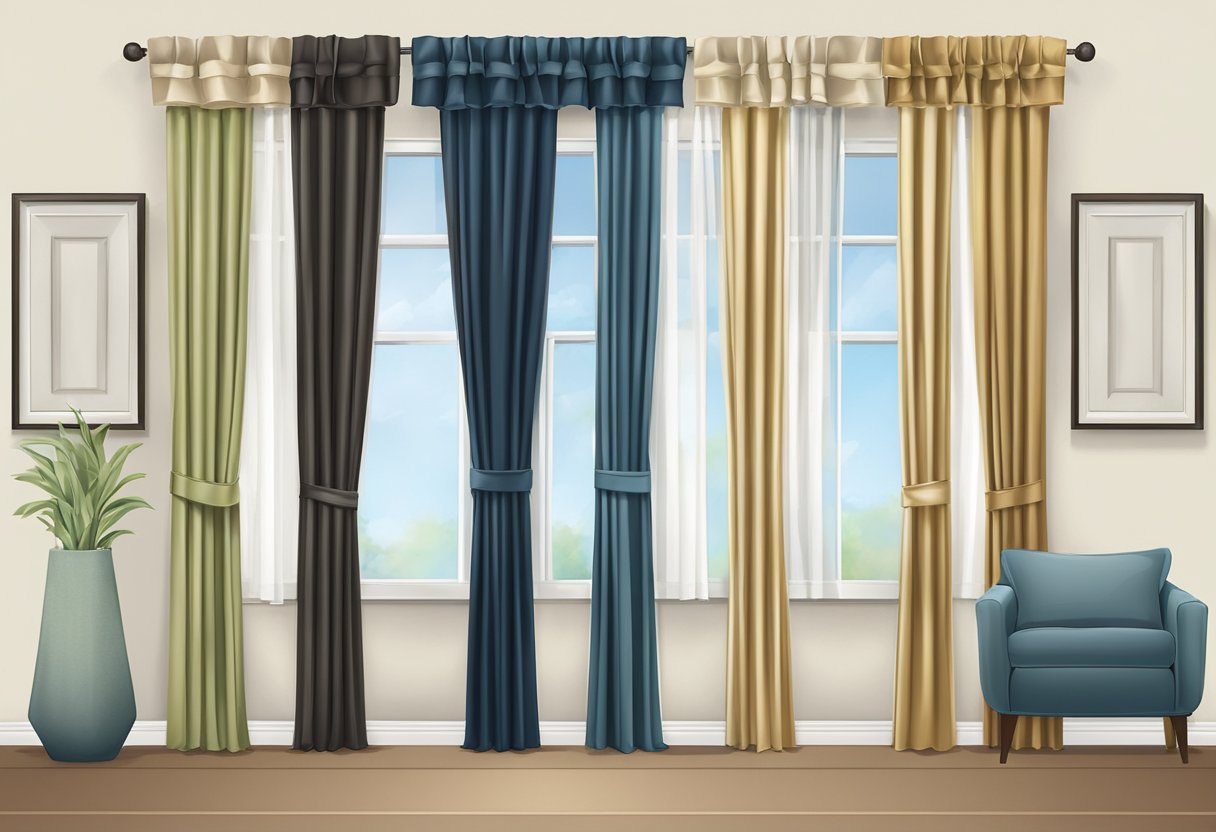Types Of Curtains
Curtains are an essential part of any home décor. They not only add beauty to the room but also serve practical purposes like controlling light and providing privacy. With so many types of curtains available in the market, it can be overwhelming to choose the right one. In this article, we will explore the different types of curtains and help you choose the perfect one for your home.
Understanding Curtain Types
Before we dive into the different types of curtains, it is essential to understand the basic types of curtains. Curtains can be classified into two broad categories: decorative and functional. Decorative curtains are used to enhance the beauty of the room, while functional curtains serve a practical purpose like blocking light or providing privacy.
Choosing the Right Fabric and Material
The choice of fabric and material is crucial when it comes to curtains. The fabric you choose will determine the look and feel of the curtains, as well as their durability. Some popular fabrics for curtains include cotton, linen, silk, and velvet. The material you choose will depend on your preference, budget, and the purpose of the curtains. For instance, if you want curtains that block out light, you may want to choose a heavy material like velvet.
Key Takeaways
- Curtains can be classified into decorative and functional categories.
- The choice of fabric and material is crucial when it comes to curtains.
- Curtain styles and window treatments can greatly impact the look and feel of a room.
Understanding Curtain Types

When it comes to choosing the right curtains for your home, there are a variety of types to choose from depending on your needs. Here are some of the most common types of curtains and their characteristics.
Panel Pair and Single Panel Curtains
Panel pair and single panel curtains are some of the most common types of curtains. Panel pair curtains consist of two separate panels that hang on either side of the window, while single panel curtains are just one panel that covers the entire window. These curtains can be made from a variety of materials, including cotton, linen, and silk, and can be used in any room of the house.
Pleated Curtains
Pleated curtains are a classic style that can add elegance to any room. These curtains feature pleats that are sewn into the fabric, giving them a tailored look. There are several types of pleats to choose from, including pinch pleat, goblet pleat, and cartridge pleat. Pinch pleat curtains are the most common, and they feature small folds at the top of the curtain that are pinched together.
Tab Top and Grommet Curtains
Tab top and grommet curtains are popular choices for modern homes. Tab top curtains have fabric loops at the top of the panel that slip over a curtain rod, while grommet curtains have metal rings that are sewn into the top of the panel. Both types of curtains are easy to install and can be made from a variety of materials, including cotton, linen, and polyester.
Sheer and Blackout Curtains
Sheer and blackout curtains are two opposite types of curtains that serve different purposes. Sheer curtains are made from lightweight, translucent fabrics that allow light to filter through while still providing privacy. They are a great choice for living rooms and dining rooms where natural light is desired. Blackout curtains, on the other hand, are made from heavy, opaque fabrics that block out all light. They are ideal for bedrooms and nurseries where a dark environment is needed for sleeping.
In summary, there are many different types of curtains to choose from, each with its own unique characteristics. Whether you’re looking for a classic, tailored look or a modern, minimalist style, there’s a type of curtain that will suit your needs.
Choosing the Right Fabric and Material
When it comes to choosing the right fabric for your curtains, there are a few things to consider. The type of fabric you choose will affect the look, feel, and function of your curtains. Here are some key factors to consider when choosing the right fabric and material for your curtains.
Natural vs Synthetic Fabrics
One of the first decisions you’ll need to make when choosing curtain fabric is whether to go with a natural or synthetic material. Natural fabrics like linen and cotton are breathable and offer a classic, timeless look. They’re also a great option if you’re looking for light filtering curtains. Synthetic fabrics like polyester are often more durable and easier to care for, making them a good choice for high-traffic areas or rooms with kids or pets.
Specialty Fabrics for Various Functions
There are also specialty fabrics available that can help enhance the function of your curtains. For example, if you’re looking for insulation, consider velvet or other heavy fabrics that will help keep the heat in during the winter months. If you want to block out light completely, look for blackout curtains made from a thick, opaque material. For a more decorative look, lace curtains can add a touch of elegance to any room.
When choosing the right fabric and material for your curtains, it’s important to consider both form and function. Think about the look and feel you want to achieve, as well as any practical considerations like insulation or light filtering. With the right fabric and material, you can create curtains that are both beautiful and functional.
Curtain Styles and Window Treatments
From Classic to Contemporary
Curtains are an essential part of any home decor. They not only provide privacy but also enhance the aesthetic appeal of a room. When it comes to choosing the right curtains, there are a plethora of options to choose from. From traditional styles to contemporary designs, there is something for everyone.
One popular style is the ripple fold curtains. These curtains have a unique wave-like pattern that adds a touch of elegance to any room. They are perfect for living rooms and bedrooms, where a classic look is desired.
Cafe curtains are another popular choice for kitchens and bathrooms. They are short curtains that cover only the lower half of the window, providing privacy while still allowing natural light to enter the room. These curtains come in a variety of styles, from plain to patterned, making them a versatile option for any decor.
Specialized Curtains for Different Rooms
When it comes to choosing curtains, it is important to consider the room they will be used in. Bedrooms, for example, require curtains that provide privacy and block out light. Blackout curtains are a great option for bedrooms, as they are designed to block out light and noise, creating a peaceful environment for sleeping.
Living rooms, on the other hand, require curtains that are both functional and stylish. Sheer curtains are a great option for living rooms, as they allow natural light to enter the room while still providing privacy. They also come in a variety of patterns and colors, making them a versatile option for any decor.
In kitchens, curtains are often used to add a pop of color or pattern to the room. Valances are a popular option for kitchens, as they are short curtains that cover only the top of the window. They come in a variety of styles, from ruffled to straight, making them a great option for any kitchen decor.
When it comes to bathrooms, privacy is key. Roman shades are a popular option for bathrooms, as they provide privacy while still allowing natural light to enter the room. They also come in a variety of colors and patterns, making them a stylish option for any bathroom decor.
Overall, choosing the right curtains for your home can be a daunting task, but with the right information, it can be a fun and rewarding experience. By considering the style and function of each room, you can choose curtains that not only enhance the aesthetic appeal of your home but also provide the privacy and functionality you need.
Color, Pattern, and Design Considerations
When it comes to choosing curtains, there are several factors to consider, including color, pattern, and design. These elements can have a significant impact on the overall look and feel of a room, making it important to choose wisely.
Coordinating with Interior Decor
One of the most important considerations when choosing curtains is coordinating them with the existing interior decor. This means taking into account the color and style of the walls, furniture, and accessories in the room. For example, if the walls are a neutral color, bold or patterned curtains can add some much-needed drama and visual interest. On the other hand, if the walls are already quite busy, solid-colored curtains in a coordinating shade can help tie everything together.
Creating Moods with Colors and Patterns
Curtains can also be used to create specific moods in a room. For example, bright and bold colors can create a lively and energetic atmosphere, while soft pastels can create a calming and relaxing environment. Similarly, patterns can also have a significant impact on the mood of a room. Bold prints can add drama and a focal point to a space, while more subtle patterns can create a sense of texture and depth.
When choosing colors and patterns for curtains, it’s important to consider the overall style of the room. For example, a traditional room may benefit from rich, warm colors and classic patterns, while a more modern space may benefit from cooler tones and geometric prints.
Ultimately, the key to choosing the right curtains for a room is to consider all of the design elements in play and choose something that complements them without overwhelming them. By taking the time to carefully consider color, pattern, and design, it’s possible to create a cohesive and visually appealing space that feels both comfortable and stylish.
Installation and Accessories
Choosing the Right Curtain Rod
When it comes to hanging curtains, choosing the right curtain rod is just as important as selecting the right curtains. Curtain rods come in a variety of materials, including wood, metal, and plastic, and can be mounted either inside or outside the window frame. The size of the rod should be determined by the width of the window and the weight of the curtains.
For heavier curtains, it is recommended to use a thicker, sturdier rod made of metal or wood. Metal rings can also be used to help support the weight of the curtains and prevent them from sagging over time.
Accessorizing with Tiebacks and Valances
Tiebacks and valances are great accessories to enhance the look of curtains. Curtain tiebacks are used to hold back curtains from the window, allowing more light to enter the room. They come in a variety of styles, including tassels, ropes, and fabric strips, and can be matched to the color and style of the curtains.
Valances are decorative pieces of fabric that are hung at the top of the window. They can be used on their own or in conjunction with curtains to add a touch of elegance to any room. Valances come in a variety of styles, including swag, scarf, and balloon, and can be made of a variety of materials, including lace, silk, and cotton.
When selecting tiebacks and valances, it is important to consider the color, pattern, and style of the curtains to ensure a cohesive look. Bold and colorful accessories can add a pop of color to a neutral room, while subtle and understated accessories can complement a bold pattern or color scheme.






